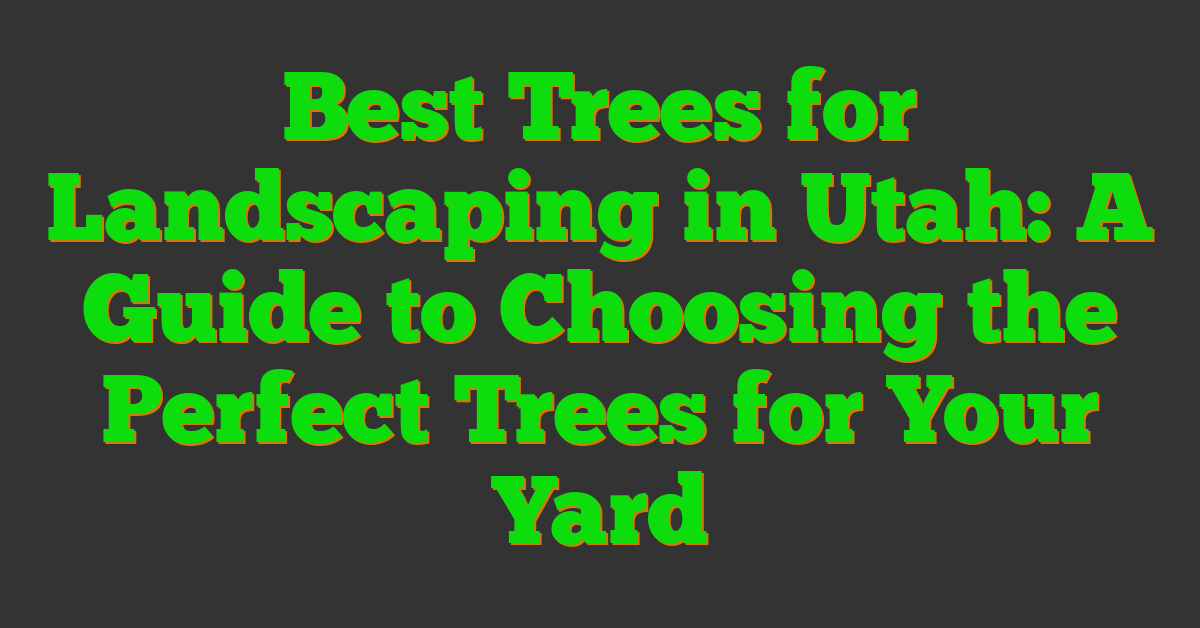If you’re looking to add some greenery to your Utah landscape, selecting the right trees is key. Not only do trees provide shade and beauty, but they also play an important role in water conservation and can even increase property value. However, with Utah’s unique climate and soil conditions, it’s important to choose trees that will thrive in these conditions.

Understanding Utah’s climate and soil is crucial for selecting the right trees for your landscape. Utah’s climate is characterized by hot summers, cold winters, and low humidity. In addition, Utah’s soil is often alkaline and high in clay content. These conditions can be challenging for many trees, but there are several trees that are well-suited for Utah’s climate and soil.
Key Takeaways
- Selecting the right trees is crucial for a successful Utah landscape.
- Understanding Utah’s climate and soil is important for choosing trees that will thrive.
- There are several trees that are well-suited for Utah’s unique conditions.
Understanding Utah’s Climate and Soil

https://www.youtube.com/watch?v=1BhzLlBGQkU&embed=true
When it comes to landscaping in Utah, it’s important to understand the climate and soil. Utah’s climate is generally arid with hot summers and cold winters. The state is also known for its dry climate, which can make it challenging to grow certain trees and plants.
Utah’s soil can also be challenging. The state has a high alkaline content in its soil, which can make it difficult for some plants to thrive. Additionally, Utah’s soil is often rocky and lacks nutrients, making it important to choose trees and plants that can tolerate these conditions.
Utah’s precipitation varies depending on the region. The northern part of the state receives more precipitation than the southern part, which is more arid. In addition, Utah’s elevation can also impact precipitation levels. Higher elevations typically receive more precipitation than lower elevations.
Utah is also known for its snow. In fact, the state is famous for its ski resorts and winter sports. However, the snow can also impact landscaping. Heavy snowfall can damage trees and plants, so it’s important to choose trees that can withstand heavy snow loads.
Overall, when choosing trees for landscaping in Utah, it’s important to select trees that can tolerate the state’s dry climate, high alkaline soil, and occasional heavy snowfall. By selecting the right trees for your yard, you can create a beautiful and sustainable landscape that will thrive in Utah’s unique climate and soil conditions.
Importance of Selecting the Right Trees
https://www.youtube.com/watch?v=GwDGiAkFBSc&embed=true
Choosing the right trees for your landscape is an important decision that can have a significant impact on the overall look and feel of your property. Trees are not only aesthetically pleasing, but they also provide a range of benefits, including shade, privacy, visual screening, and wildlife habitat. In addition, selecting water-wise and native plants can help conserve water and reduce maintenance costs.
One of the most significant benefits of trees is their ability to provide shade. Trees can help reduce the amount of heat that enters your home during the summer months, which can help lower your energy bills. In addition, shade trees can provide a comfortable outdoor living space where you can relax and enjoy the beauty of your surroundings.
Another important consideration when selecting trees for your landscape is their beauty. Trees can add color, texture, and depth to your property, creating an inviting and attractive environment. Flowering trees, such as the Eastern Redbud, Japanese Tree Lilac, and Douglas Hawthorn, can burst with gorgeous, colorful blooms that will add beauty to your property.
Trees can also provide privacy and visual screening, which is particularly important if you live in a densely populated area. Tall trees, such as the Colorado Blue Spruce or the Austrian Pine, can provide a natural barrier that blocks noise and creates a sense of seclusion.
Wildlife habitat is another important consideration when selecting trees for your landscape. Trees can provide food and shelter for a variety of wildlife species, including birds, squirrels, and rabbits. In addition, trees can help support the local ecosystem by providing a habitat for beneficial insects and other organisms.
Finally, selecting water-wise and native plants can help conserve water and reduce maintenance costs. Utah is known for its arid climate, so it’s important to choose plants that can thrive in this environment. Native plants are adapted to the local climate and require less water and maintenance than non-native species.
In summary, selecting the right trees for your landscape is an important decision that can have a significant impact on the overall look and feel of your property. Trees provide a range of benefits, including shade, beauty, privacy, visual screening, and wildlife habitat. In addition, selecting water-wise and native plants can help conserve water and reduce maintenance costs.
Popular Trees for Utah Landscaping
https://www.youtube.com/watch?v=jUoHkvMypVU&embed=true
When it comes to landscaping in Utah, choosing the right trees can make a big difference in the overall look and feel of your property. Here are some of the most popular trees for Utah landscaping:
Oak Tree
The oak tree is a great choice for Utah landscaping because it is fast-growing and provides ample shade. There are several different varieties of oak trees that grow well in Utah, including white, English, northern, and bur oak. These trees can grow up to 80 feet tall and only take a few short years to provide shade for your yard.
Apple Tree
If you’re looking for a tree that not only looks great but also provides delicious fruit, then an apple tree is a perfect choice. Apple trees are easy to care for and can be grown in a variety of soils. They also produce beautiful flowers in the spring, making them a great addition to any landscape.
Blue Spruce
The blue spruce is a popular tree in Utah because of its beautiful blue-green needles and conical shape. It is a hardy tree that can withstand Utah’s harsh winters and hot summers. The blue spruce is also a great tree for providing privacy, as it can grow up to 75 feet tall.
Hot Wings Maple
The hot wings maple is a great choice for Utah landscaping because of its stunning fall colors. This tree produces bright red leaves in the fall, making it a great addition to any landscape. It also has a unique winged seed that adds interest to the tree even after the leaves have fallen.
« Best Trees for Landscaping in Texas: Top Picks for a Lush Garden Best Trees for Landscaping in Vermont: A Guide to Choosing the Right Trees for Your Yard »
Japanese Cherry Blossom Tree
The Japanese cherry blossom tree is a beautiful tree that produces stunning pink or white flowers in the spring. It is a great choice for Utah landscaping because it is relatively low-maintenance and can be grown in a variety of soils. The Japanese cherry blossom tree is also a great tree for providing shade in the summer.
Northern Red Oak
The northern red oak is a popular tree in Utah because of its stunning fall colors. This tree produces bright red leaves in the fall, making it a great addition to any landscape. It is also a fast-growing tree that can provide ample shade in just a few short years.
Pinyon Pine
The pinyon pine is a great choice for Utah landscaping because it is a native tree that is well-adapted to Utah’s climate. It is a slow-growing tree that can grow up to 50 feet tall and provides ample shade. The pinyon pine also produces edible pine nuts, making it a great tree for both landscaping and food production.
Rose of Sharon
The rose of Sharon is a beautiful tree that produces stunning flowers in the summer. It is a great choice for Utah landscaping because it is relatively low-maintenance and can be grown in a variety of soils. The rose of Sharon is also a great tree for providing privacy, as it can grow up to 10 feet tall.
Red Maple
The red maple is a popular tree in Utah because of its stunning fall colors. This tree produces bright red leaves in the fall, making it a great addition to any landscape. It is also a fast-growing tree that can provide ample shade in just a few short years.
Planting and Care for Landscape Trees
https://www.youtube.com/watch?v=us78iBEMihk&embed=true
Planting a tree in your yard is an investment in the future of your property and the environment. Fall is the best time to plant trees in Utah, as the cooler temperatures and increased rainfall help trees establish their root systems before winter.
When planting a tree, it is important to choose a location that provides adequate space for the tree’s mature size and root system. Smaller trees can be planted closer to structures, but larger trees should be planted at least 15 feet away from your house and other structures, and avoid planting landscaping trees under utility lines as they could interfere with the lines as they grow taller.
When planting a tree, dig a hole that is two to three times wider than the root ball, but no deeper than the root ball. Loosen the soil around the edges of the hole to help the roots establish themselves. When placing the tree in the hole, make sure the root flare is at or slightly above ground level. Backfill the hole with the soil that was removed, and water the tree thoroughly.
Proper care and maintenance of your landscape trees is essential for their growth and longevity. Water newly planted trees thoroughly, applying the water with a hose or bucket to the entire planting area and letting it soak in well. After the first year, trees need about one inch of water per week during the growing season.
Fertilizing your trees can also help them grow strong and healthy. Use a slow-release fertilizer in the spring, following the manufacturer’s instructions. Avoid fertilizing in the fall, as this can encourage new growth that is susceptible to winter damage.
Regularly inspecting your trees for signs of pests or disease can help prevent problems before they become severe. Prune your trees in the late winter or early spring to remove dead or damaged branches and promote healthy growth.
If you live in an area with harsh winter weather, wrapping the trunk of your tree in burlap can help protect it from sunscald and frost cracks. Make sure to remove the burlap in the spring to prevent the tree from becoming girdled.
By following these simple planting and care tips, you can help your landscape trees thrive for years to come.
Dealing with Common Tree Diseases and Pests
https://www.youtube.com/watch?v=b9Bd9gW_gEI&embed=true
Maintaining healthy trees in your Utah landscape can be a challenge due to the harsh climate and the prevalence of pests and diseases. Here are some common issues you may encounter and how to deal with them.
Disease
Anthracnose is a common disease among deciduous trees, especially sycamore, ash, and oak. It causes unsightly dark, sunken lesions on leaves, stems, flowers, and fruits. Anthracnose fungi need water to spread and infect, so the disease is more prevalent during wet, cold springs.
Apple scab is a disease that affects apple and crabapple trees. The fungal infection produces lesions with a scab-like appearance on leaves and fruit. Although apple scab does not usually kill trees, it can weaken them and make them more susceptible to other diseases.
Pests
Lilac borer is a common pest in Utah that attacks lilacs, ash, and privet trees. The larvae of the borer tunnel into the tree and cause damage to the cambium layer, which can weaken the tree and make it more susceptible to disease. Signs of infestation include wilting leaves, dieback, and sawdust-like frass.
Iron chlorosis is a condition that affects many types of trees in Utah, including maples, oaks, and birches. It is caused by a lack of iron in the soil, which can result in yellowing leaves and stunted growth. To prevent iron chlorosis, make sure your trees are planted in well-draining soil and use iron supplements as needed.
Prevention
Preventing tree diseases and pests is always easier than treating them. Here are some tips to keep your trees healthy:
- Choose trees that are well-suited to Utah’s climate and soil conditions.
- Plant trees in well-draining soil and avoid overwatering.
- Prune trees regularly to remove dead or diseased branches.
- Use organic mulch to help retain moisture and prevent weed growth.
- Use insecticidal soap or horticultural oil to control pests.
By following these tips and keeping an eye out for signs of disease and pests, you can help ensure that your trees stay healthy and beautiful for years to come.
Understanding Hardiness Zones in Utah
https://www.youtube.com/watch?v=iHJi51gWEwk&embed=true
When selecting trees for landscaping in Utah, it’s important to understand the hardiness zones in the state. Hardiness zones are based on the average annual minimum temperature and help gardeners determine which plants are most likely to thrive in a particular area.
According to the USDA Hardiness Zone Map, Utah is divided into four zones: 4b, 5a, 5b, and 6a. The zones are determined by the average annual minimum temperature, with 4b being the coldest zone and 6a being the warmest.
Salt Lake City, one of the most populous cities in Utah, falls under Zone 7a. This means that the average annual minimum temperature in Salt Lake City is between 0 and 5 degrees Fahrenheit.
When selecting trees for landscaping, it’s important to choose ones that are hardy enough to survive in your specific hardiness zone. Some trees may not be able to survive the colder temperatures of Zone 4b, while others may not be able to handle the warmer temperatures of Zone 6a.
It’s also important to consider other factors when selecting trees for landscaping, such as soil type, drainage, and sun exposure. Thoroughly researching and selecting the right trees for your specific location can help ensure that your landscaping thrives and looks beautiful for years to come.
The Role of Trees in Water Conservation
https://www.youtube.com/watch?v=LbZvOL0dgyU&embed=true
If you’re looking to conserve water in your Utah landscape, planting trees is a smart choice. Trees play a significant role in promoting sustainable water management by reducing runoff, improving soil health, and conserving water through their own efficient water usage.
One of the biggest benefits of trees is their ability to intercept and store rainwater. According to a study, a single tree in Minneapolis intercepts an average of 1,685 gallons of rainwater each year, which would otherwise become runoff. Multiply this effect by the city’s estimated 200,000 street trees, and you can see the impact trees can have on water conservation efforts.
Trees also help to improve soil moisture by reducing evaporation and increasing infiltration. Their roots create channels through which water can flow into the soil, helping to recharge groundwater supplies. Additionally, trees can help to reduce the amount of water lost to evapotranspiration by providing shade, which keeps soil temperatures cooler and reduces water loss.
Another way trees help with water conservation is through their own efficient water usage. Trees have evolved to be very efficient at using water, and they can survive on less water than many other plants. By planting trees that are well-suited to Utah’s climate, you can reduce the amount of water needed to keep your landscape healthy.
Overall, planting trees is an excellent way to conserve water in your Utah landscape. By reducing runoff, improving soil moisture, and using water efficiently, trees can help you create a beautiful and sustainable landscape that requires less water to maintain.
Incorporating Shrubs and Other Plants
https://www.youtube.com/watch?v=khONBO14cqM&embed=true
When it comes to landscaping, trees are not the only option. Shrubs, ornamental grasses, ground covers, and herbaceous perennials can all play a role in creating a beautiful and diverse landscape. Here are some tips for incorporating these plants into your Utah landscape:
Shrubs
Shrubs can add structure and texture to your landscape, and they come in a wide variety of shapes, sizes, and colors. Some popular shrubs for Utah landscapes include:
- Lilacs: These fragrant shrubs are a Utah favorite, with their beautiful purple or white blooms in the spring.
- Butterfly Bush: This shrub gets its name from the butterflies that are attracted to its fragrant blooms. It comes in a variety of colors, including purple, pink, and white.
- Spirea: This shrub has delicate pink or white flowers that bloom in the spring, and its foliage turns a beautiful red or orange in the fall.
When choosing shrubs for your landscape, consider their mature size and shape, as well as their growing requirements. Some shrubs prefer full sun, while others do better in partial shade.
Ornamental Grasses
Ornamental grasses can add movement and texture to your landscape, and they are also low-maintenance. Some popular ornamental grasses for Utah landscapes include:
- Blue Fescue: This grass has blue-gray foliage that adds a cool, calming effect to your landscape.
- Maiden Grass: This tall grass has feathery plumes that sway in the breeze, adding movement and interest to your landscape.
- Switchgrass: This native grass has a striking upright form and turns a beautiful red or orange in the fall.
Ornamental grasses are generally low-maintenance, but they do need to be cut back in the spring to make way for new growth.
Ground Covers
Ground covers can be used to fill in gaps between larger plants, or to create a low-maintenance lawn alternative. Some popular ground covers for Utah landscapes include:
- Creeping Thyme: This fragrant ground cover has tiny purple flowers that bloom in the spring and summer.
- Creeping Jenny: This low-growing plant has yellow-green foliage that adds a bright pop of color to your landscape.
- Sedum: This succulent ground cover comes in a variety of colors and textures, and it is low-maintenance and drought-tolerant.
Ground covers are a great option for areas with poor soil or difficult growing conditions.
Herbaceous Perennials
Herbaceous perennials are plants that die back to the ground each winter, but come back year after year. Some popular herbaceous perennials for Utah landscapes include:
- Coneflowers: These colorful flowers come in a variety of shades, from pink to orange to yellow.
- Black-eyed Susans: These bright yellow flowers bloom in the summer and fall, and they are a favorite of bees and butterflies.
- Daylilies: These hardy plants come in a variety of colors and bloom throughout the summer.
When choosing herbaceous perennials for your landscape, consider their growing requirements and bloom time, as well as their mature size and shape.
By incorporating shrubs, ornamental grasses, ground covers, and herbaceous perennials into your Utah landscape, you can create a beautiful and diverse outdoor space that you can enjoy for years to come.
Designing a Low-Maintenance Landscape
https://www.youtube.com/watch?v=hRjCmvFV_I0&embed=true
Designing a low-maintenance landscape for your Utah yard or property is a great way to save time, money, and energy. By selecting the right trees and plants, you can enjoy a beautiful landscape without the need for constant upkeep.
When designing your low-maintenance landscape, consider the amount of sunlight your property receives throughout the day and during different seasons. This will help you choose the best trees and plants for your yard that will thrive in your specific conditions.
Fall colors are also an important consideration when selecting trees for your landscape. Utah is known for its stunning fall foliage, so be sure to choose trees that will add to the beauty of the season.
To make your low-maintenance landscape even more manageable, consider incorporating hardscaping elements such as rocks, gravel, or pavers. These features require little to no maintenance and can add to the overall aesthetic of your landscape.
In addition, consider using ground covers such as clover or mulch to eliminate the need for regular mowing and watering.
By following these tips and selecting the right trees and plants for your Utah landscape, you can enjoy a beautiful and low-maintenance yard all year round.
Resources for Utah Landscaping
https://www.youtube.com/watch?v=Dlyf6q46PxM&embed=true
When it comes to landscaping your yard in Utah, it can be helpful to know where to turn for resources and information. Here are a few options to consider:
USU Extension
The Utah State University Extension offers a wealth of information on gardening, landscaping, and forestry. Their website, extension.usu.edu/forestry, provides information on tree selection, planting, care, and more. They also have resources specific to Utah’s climate and soil conditions, which can be helpful when choosing plants for your yard.
Local Nurseries
Local nurseries can be a great resource for finding trees and shrubs that are well-suited for Utah’s climate. Many nurseries in the area carry a variety of trees and shrubs that are specifically chosen for their ability to thrive in our unique climate. Additionally, the staff at these nurseries can often provide helpful advice on planting and care.
Online Resources
There are many online resources available for those looking to landscape their yard in Utah. In addition to the USU Extension website, there are many gardening and landscaping blogs and forums that can provide helpful tips and advice. Just be sure to verify the accuracy of any information you find online, as not all sources may be reliable.
Professional Landscapers
If you’re feeling overwhelmed or unsure about how to proceed with your landscaping project, consider hiring a professional landscaper. A professional can provide guidance on tree selection, placement, and care, as well as take care of the planting and maintenance for you. Just be sure to choose a reputable landscaper with experience working in Utah’s climate.
By utilizing these resources, you can make informed decisions about landscaping your yard in Utah and ensure that your trees and shrubs thrive for years to come.
Frequently Asked Questions
https://www.youtube.com/watch?v=QRl3puYcC6M&embed=true
What are some small drought tolerant trees that thrive in Utah?
If you’re looking for small trees that can withstand Utah’s dry climate, consider planting a Russian Hawthorn or a Utah Serviceberry. Both of these trees are drought tolerant and can add a touch of beauty to your landscape.
What are the best fast growing shade trees for Utah?
If you want to quickly add some shade to your yard, consider planting a Hybrid Poplar or a Quaking Aspen. Both of these trees are fast growing and can provide ample shade in just a few years.
What are some common trees found in Utah?
Utah is home to a variety of trees, including the Quaking Aspen, Ponderosa Pine, and Douglas Fir. These trees are well-suited to Utah’s climate and can add natural beauty to your landscape.
What are some columnar trees that are well-suited for Utah?
Columnar trees can add height and visual interest to your landscape without taking up too much space. Consider planting a Skyrocket Juniper or a Columnar Blue Spruce for a unique look.
What are the best flowering trees to plant in Utah?
If you want to add some color to your landscape, consider planting a Crabapple or a Cherry tree. Both of these trees produce beautiful flowers in the spring and can add a pop of color to your yard.
What are some good options for trees to plant in the front and back yards of a Utah home?
For the front yard, consider planting a Japanese Maple or a Magnolia tree. Both of these trees are visually appealing and can add curb appeal to your home. For the backyard, consider planting a fruit tree like an Apple or a Peach tree. Not only do these trees produce delicious fruit, but they can also add natural beauty to your landscape.











